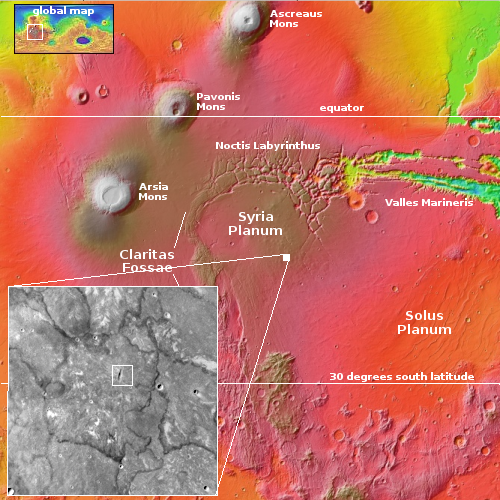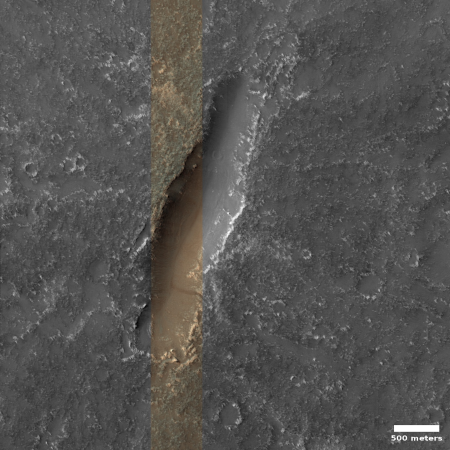A somewhat typical volcanic vent on Mars

With today’s cool image we begin with the overview map to the right. The white dot marks the location, within the region on Mars dubbed the Tharsis Bulge, where four of its biggest volcanoes are located on a surface that has been pushed significantly above the red planet’s mean “sea level.”
The small rectangle in the inset shows the area covered by the cool image below. The focus is on a two-mile-long and half-mile-wide depression that sits on a relatively flat landscape of few craters.
If you look at the inset closely, you will notice this depression is surrounded by a dark borderline on all four sides, ranging in distance from three to thirteen miles. The grade to that borderline is downhill in all directions, with the drop ranging roughly from 800 to 1,000 feet.

Click for original image.
The picture to the right, rotated, cropped, and reduced to post here, was taken on August 26, 2025 by the high resolution camera on Mars Reconnaissance Orbiter (MRO). The camera team labels it a “low shield summit vent,” meaning they consider this to be a volcanic vent from which lava once poured, creating that low relatively flat cone — which geologists dub a “shield volcano,” bordered by that dark line.
Though the ages are not yet confirmed, rough estimates based on crater counts suggest this region was volcanically active from two to three billion years ago. Since Martian lava is less viscous than on Earth, it flows more like water, thus explaining the relatively smooth and flat landscape. Since then there has been plenty of time to smooth things even more, aided by a layer of Martian dust deposited here by the planet’s thin atmosphere. That dust now mostly fills the vent’s bottom, as the dust gets trapped there should it fall in.
Note also the slope streak on one wall. This unique Martian phenomenon, which does not change the topography and can even travel uphill for short periods, remains unexplained, though the most popular theory says it is caused by dust getting disturbed by wind at its top.
On Christmas Eve 1968 three Americans became the first humans to visit another world. What they did to celebrate was unexpected and profound, and will be remembered throughout all human history. Genesis: the Story of Apollo 8, Robert Zimmerman's classic history of humanity's first journey to another world, tells that story, and it is now available as both an ebook and an audiobook, both with a foreword by Valerie Anders and a new introduction by Robert Zimmerman.
The print edition can be purchased at Amazon or from any other book seller. If you want an autographed copy the price is $60 for the hardback and $45 for the paperback, plus $8 shipping for each. Go here for purchasing details. The ebook is available everywhere for $5.99 (before discount) at amazon, or direct from my ebook publisher, ebookit. If you buy it from ebookit you don't support the big tech companies and the author gets a bigger cut much sooner.
The audiobook is also available at all these vendors, and is also free with a 30-day trial membership to Audible.
"Not simply about one mission, [Genesis] is also the history of America's quest for the moon... Zimmerman has done a masterful job of tying disparate events together into a solid account of one of America's greatest human triumphs."--San Antonio Express-News

With today’s cool image we begin with the overview map to the right. The white dot marks the location, within the region on Mars dubbed the Tharsis Bulge, where four of its biggest volcanoes are located on a surface that has been pushed significantly above the red planet’s mean “sea level.”
The small rectangle in the inset shows the area covered by the cool image below. The focus is on a two-mile-long and half-mile-wide depression that sits on a relatively flat landscape of few craters.
If you look at the inset closely, you will notice this depression is surrounded by a dark borderline on all four sides, ranging in distance from three to thirteen miles. The grade to that borderline is downhill in all directions, with the drop ranging roughly from 800 to 1,000 feet.

Click for original image.
The picture to the right, rotated, cropped, and reduced to post here, was taken on August 26, 2025 by the high resolution camera on Mars Reconnaissance Orbiter (MRO). The camera team labels it a “low shield summit vent,” meaning they consider this to be a volcanic vent from which lava once poured, creating that low relatively flat cone — which geologists dub a “shield volcano,” bordered by that dark line.
Though the ages are not yet confirmed, rough estimates based on crater counts suggest this region was volcanically active from two to three billion years ago. Since Martian lava is less viscous than on Earth, it flows more like water, thus explaining the relatively smooth and flat landscape. Since then there has been plenty of time to smooth things even more, aided by a layer of Martian dust deposited here by the planet’s thin atmosphere. That dust now mostly fills the vent’s bottom, as the dust gets trapped there should it fall in.
Note also the slope streak on one wall. This unique Martian phenomenon, which does not change the topography and can even travel uphill for short periods, remains unexplained, though the most popular theory says it is caused by dust getting disturbed by wind at its top.
On Christmas Eve 1968 three Americans became the first humans to visit another world. What they did to celebrate was unexpected and profound, and will be remembered throughout all human history. Genesis: the Story of Apollo 8, Robert Zimmerman's classic history of humanity's first journey to another world, tells that story, and it is now available as both an ebook and an audiobook, both with a foreword by Valerie Anders and a new introduction by Robert Zimmerman.
The print edition can be purchased at Amazon or from any other book seller. If you want an autographed copy the price is $60 for the hardback and $45 for the paperback, plus $8 shipping for each. Go here for purchasing details. The ebook is available everywhere for $5.99 (before discount) at amazon, or direct from my ebook publisher, ebookit. If you buy it from ebookit you don't support the big tech companies and the author gets a bigger cut much sooner.
The audiobook is also available at all these vendors, and is also free with a 30-day trial membership to Audible.
"Not simply about one mission, [Genesis] is also the history of America's quest for the moon... Zimmerman has done a masterful job of tying disparate events together into a solid account of one of America's greatest human triumphs."--San Antonio Express-News

